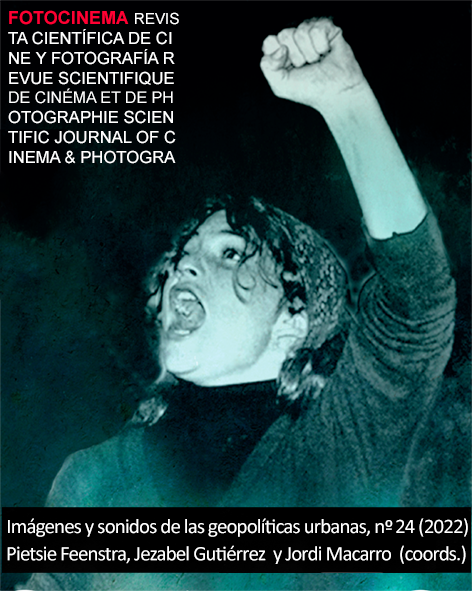Identidades visuales de la Nueva Movida en el paisaje urbano desde la fotografía española
Cambios y paradigmas generacionales construyendo una mirada de Madrid
DOI:
https://doi.org/10.24310/Fotocinema.2022.vi24.13665Keywords:
Nueva Movida, Movida, Photography, Madrid, Spanish, Urban LandscapeAbstract
The cultural context of the Movida has changed to put aside the common spaces built by the community to lead to an individualistic and adolescent landscape that disdains adult responsibilities. The Nueva Movida has developed a youthful and intimate photography in which the subject has also become the creator of his own gender and sexuality. However, both generations occur in the urban context of Madrid; an urban landscape that has changed its way of looking and being looked by itself, to develop a place that works, no longer for the community of the eighties, but for the unique and individualized being of the new century. The present study tries to focus on the treatment of Madrid in the photography practiced by a generation that has been named as the natural heir of the streets of the city.
Downloads
Metrics
Publication Facts
Reviewer profiles N/A
Author statements
Indexed in
-
—
- Academic society
- N/A
- Publisher
- Universidad de Málaga
References
Baudrillard, J.,(2006). El complot del arte. Ilusión y desilusión estéticas, Buenos Aires: Amorrortu.
Benjamin, W. (2018). Walter Benjamin. Iluminaciones, Barcelona: Taurus
Borgman, C. L. (2015). Big data, little data, no data: scholarship in the networked world. MIT Press.
Castells, M. (2012) Redes de indignación y esperanza: Los movimientos sociales en la era de Internet, Madrid: Alianza Editorial. Castilla, P. (2021). La nueva movida madrileña. Harper´s Bazaar. Recuperado de https://www.harpersbazaar.com/es/cultura/ocio/a35265314/nueva-movida-madrilena-cultura-madrid/
Castro, E. (2019). El trap. Filosofía millenial para la crisis en España, Madrid: Errata Naturae.
De las Heras, D., García-Ergüín, M. (2021). Miradas desde la juventud la nueva movida y la construcción de la subjetividad en la fotografía de moda española. En Audiovisual e Indústrias Criativas: presente e futuro - Vol. 1. (pp. 307-322). Madrid, España: McGraw Hill.
Delgado, M. (2015). Urban Youth and Photovoice: Visual Ethnography in Action, New York: Oxford University Press.
Efetur (2018) Efe:tur Viajes. Madrid. Recuperado de https://www.google.com/search?client=safari&rls=en&q=(https://www.efetur.com/noticia/locales-nocturnos-removida-madrilena/)&ie=UTF-8&oe=UTF-8
Flores, M. (2021). Y entonces surgió la “removida madrileña. El País, SModa. Recuperado de https://smoda.elpais.com/moda/surgio-la-removida-madrilena/
Gallego, M. (2007). Consideraciones sobre el uso y el lugar. En Anotaciones al margen, Barcelona, España: Gustavo Gili.
Han, Byung-Chul (2017). La expulsión de lo distinto. Barcelona: Herder.
-(2018). Hiperculturalidad, Barcelona: Herder.
Krippendorff, K. (1990). Metodología de análisis de contenido. Teoría y práctica. Barcelona: Paidós.
LaSexta (2021). Recuperado de https://www.lasexta.com/noticias/nacional/ayuso-vaticina-nueva-movida-madrilena-vivira-autentica-revolucion-que-solo-asimilable-anos-80_2021052760af9672b9c98f0001a0fe8a.html
Lipovetsky, G. (2009). La pantalla global: cultura mediática y cine en la era hipermoderna. Barcelona: Anagrama.
-(2020). Gustar y emocionar: Ensayo sobre la sociedad de la seducción, Barcelona: Anagrama.
Maliniak, T., (1990). Les espagnols: de la Movida à l´Europe. París: Centurion.
Marí, J. (2009). La movida como debate. Arizona Journal of Hispanic Cultural Studies, 13, (127-141).
Martín Prada, J.M., (2018). El ver y las imágenes en el tiempo de Internet, Madrid: Akal.
Mason, J., (1996). Qualitative Researching. Londres: Sage.
Miranda, A., (2015). El Espacio Como Ideología. Madrid: Catarata.
Moreiras Menor, C. (2010). La realidad in-visible y la espectacularización (inter)nacionalista de la Movida Madrileña: el caso de la fotografía. Revista Científica de Información y Comunicación, 7, (119-148).
Neo2 (2018). Recuperado de https://www.neo2.com/kito-munoz-absolut-manifesto-free-love/
-(2019). https://www.neo2.com/filip-custic-joven-y-viral/
Ossorno, M. (2018). My Crew - Kito Muñoz. Vice. Recuperado de https://i-d.vice.com/es/article/d35v9a/kito-munoz-my-crew
Ritchin, F., (2010). Después de la fotografía. Oaxaca: Ve.
Rivière, M. (1992). Lo cursi y el poder de la moda, Madrid: Espasa.
Serrano, N. (2018). La noche de la “removida” madrileña. ABC. Recuperado de https://www.abc.es/plan-b/aplaudir/abci-noche-removida-madrilena-201809140856_noticia.html
Urrero, G., (2003). La Movida no existe. Cuadernos Hispanoamericanos, 636, (41-49).
Vilarós, T. M. (1998): El mono del desencanto. Una crítica cultural de la transición española (1973-1993), Madrid: Siglo XXI.
Downloads
Published
How to Cite
Issue
Section
License
All contents published in Fotocinema Revista científica de cine y fotografía are protected under the Creative Commons Attribution-NonCommercial-ShareAlike 4.0 International (CC BY-NC-SA 4.0) license. All about this license is available in the following link: <http://creativecommons.org/licenses/by-nc-sa/4.0>
Users can copy, use, redistribute, share and exhibit publicly as long as:
- The original source and authorship of the material are cited (Journal, Publisher and URL of the work).
- It is not used for comercial purposes.
- The existence of the license and its especifications are mentioned.
There are two sets of authors’ rights: moral and property rights. Moral rights are perpetual prerogatives, unrenounceable, not-transferable, unalienable, imprescriptible and inembargable. According to authors’ rights legislation, Fotocinema. Revista científica de cine y fotografía recognizes and respects authors moral rights, as well as the ownership of property rights, which will be transferred to University of Malaga in open access. The property rights are referred to the benefits that are gained by the use or the dissemination of works. Fotocinema. Revista científica de cine y fotografía is published in an open access form and it is exclusively licenced by any means for doing or authorising distribution, dissemination, reproduction, , adaptation, translation or arrangement of works.
Authors are responsable for obtaining the necessary permission to use copyrighted images.














13.png)



